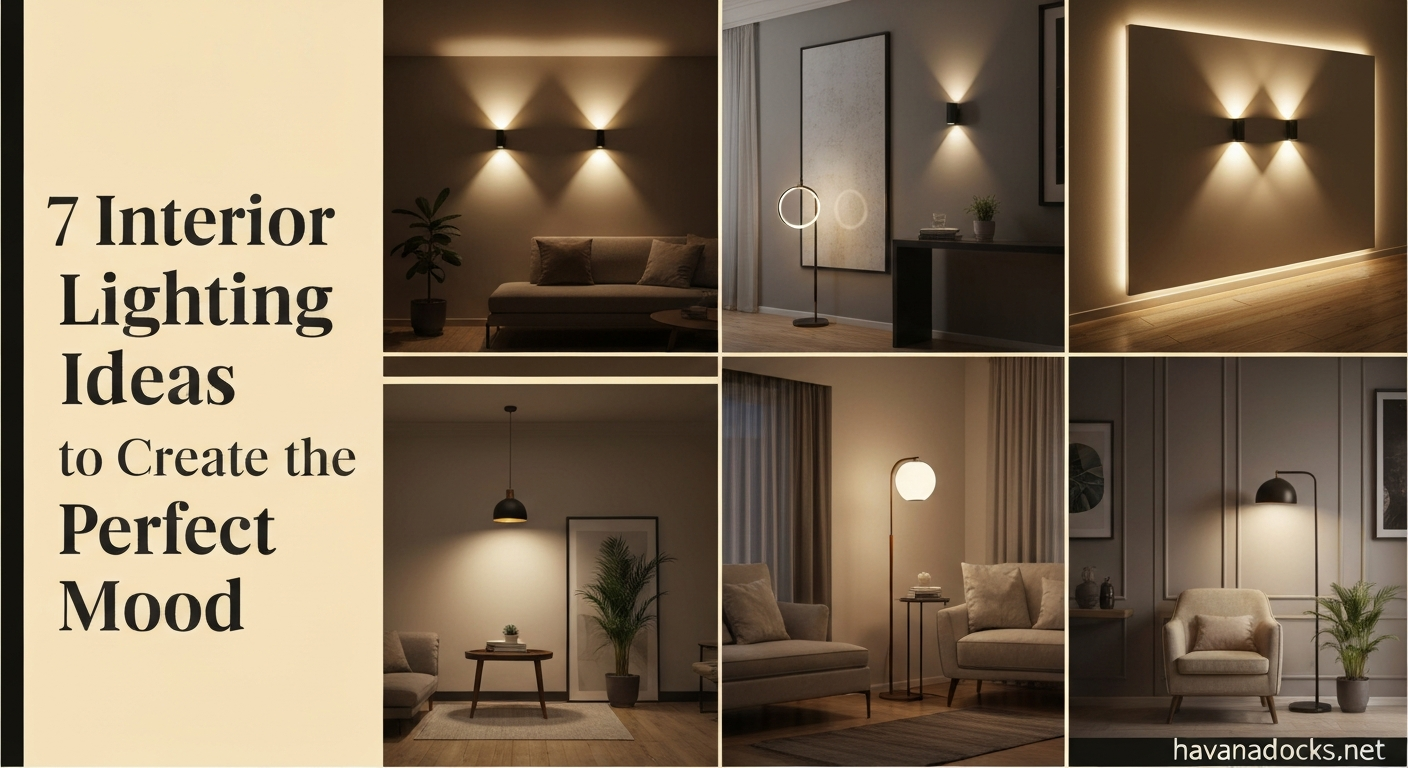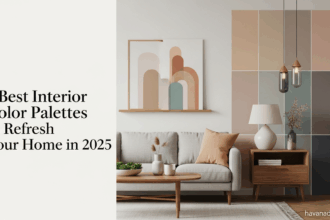7 Interior Lighting Ideas to Transform Your Space
7 Interior Lighting Ideas – Lighting is a powerful tool that can completely change the ambiance of a room. Beyond just illuminating a space, carefully chosen interior lighting ideas can evoke specific emotions, highlight architectural features, and create a welcoming atmosphere. Let’s explore seven transformative lighting techniques to help you achieve the perfect mood in your home.

1. Embrace Layered Lighting
Layered lighting is a fundamental principle in effective interior design. It involves combining three main types of lighting: ambient, task, and accent. By layering these different types, you create a dynamic and functional lighting scheme. Understanding different interior lighting ideas will allow for this flexibility.
Ambient Lighting: The Foundation
Ambient lighting, also known as general lighting, provides overall illumination to a room. It sets the base level of light and allows you to navigate the space safely. Think of it as the foundation upon which all other lighting layers are built.
- Chandeliers: Elegant and dramatic, chandeliers can serve as both a light source and a focal point.
- Recessed Lighting: Sleek and unobtrusive, recessed lights provide even and diffused illumination.
- Flush Mount Fixtures: A practical and versatile option for rooms with lower ceilings.
Task Lighting: Functionality and Focus
Task lighting provides direct illumination for specific activities, such as reading, cooking, or working. It’s essential for preventing eye strain and ensuring safety in high-use areas. Understanding interior lighting ideas for task lighting ensures efficient workspace lighting.
- Desk Lamps: Adjustable and directional, desk lamps offer focused light for reading or writing.
- Under-Cabinet Lighting: Illuminates countertops for cooking and food preparation.
- Floor Lamps: Provides adjustable light for reading nooks or beside seating areas.
Accent Lighting: Highlighting and Drama
Accent lighting is used to highlight specific objects or architectural features, adding depth and visual interest to a room. It creates drama and draws the eye to points of interest. Good interior lighting ideas use accent lighting.
- Track Lighting: Flexible and adjustable, track lighting is perfect for highlighting artwork or architectural details.
- Spotlights: Used to draw attention to specific objects or areas.
- Wall Sconces: Decorative and functional, wall sconces can add a touch of elegance and warmth.
2. Play with Color Temperature
Color temperature refers to the warmth or coolness of light, measured in Kelvins (K). Different color temperatures can evoke different moods and are crucial to consider when exploring interior lighting ideas.
Warm Light (2700K-3000K): Cozy and Relaxing
Warm light has a yellowish or orange hue, creating a cozy and relaxing atmosphere. It’s ideal for bedrooms, living rooms, and dining rooms, fostering a sense of comfort and intimacy. These interior lighting ideas are best for relaxing environments.
Neutral Light (3500K-4000K): Balanced and Versatile
Neutral light falls in between warm and cool, providing a balanced and versatile option. It’s suitable for kitchens, bathrooms, and home offices, where clarity and functionality are important.
Cool Light (5000K-6500K): Bright and Energizing
Cool light has a bluish or white hue, creating a bright and energizing atmosphere. It’s best for workspaces, garages, and areas where focus and alertness are required. Keep in mind that overly cool light can feel sterile or harsh in living spaces, so use it sparingly.
Choosing the right color temperature can significantly impact the overall mood of your space. Experiment with different options to find what works best for you.
3. Utilize Dimmers: Control the Ambiance
Dimmers are a game-changer when it comes to controlling the ambiance of your home. They allow you to adjust the intensity of light, creating a range of moods from bright and energizing to dim and relaxing. Incorporating dimmers into your interior lighting ideas will greatly add to the experience.
Create a Relaxing Evening Atmosphere
Dimming the lights in the evening can help you unwind and prepare for sleep. Lowering the light intensity signals to your body that it’s time to relax, promoting a sense of calm and tranquility.
Enhance Special Occasions
Dimmers are invaluable for setting the mood for special occasions, like dinner parties or movie nights. You can easily adjust the lighting to create the perfect ambiance for any event.
Save Energy
Dimming your lights not only enhances the ambiance but also saves energy. Using lower light levels reduces energy consumption, helping you save money on your electricity bill.
Modern smart bulbs also allow for color temperature adjustment, so you can dial in the perfect light based on the time of day and your mood.
4. Incorporate Natural Light
Natural light is the most flattering and beneficial type of light. It enhances colors, boosts mood, and provides essential Vitamin D. Maximizing natural light should be a priority when considering interior lighting ideas.
Utilize Mirrors
Mirrors are a fantastic way to amplify natural light. Place them strategically to reflect light and brighten up a room. They can also create the illusion of more space.
Choose Light-Colored Window Treatments
Light-colored curtains or blinds allow more natural light to filter into your room. Avoid heavy, dark fabrics that block light and make the room feel gloomy.
Keep Windows Clean
Clean windows allow maximum light to pass through. Make sure to clean your windows regularly to keep them sparkling and bright.
If you don’t have much natural light, consider using full-spectrum light bulbs to mimic the effects of sunlight.
5. Consider Smart Lighting Systems
Smart lighting systems offer a range of advanced features, allowing you to control your lights remotely, automate lighting schedules, and even change the color of your lights. When looking into your interior lighting ideas, smart lighting systems can add a lot of versatility.
Remote Control
Control your lights from anywhere using your smartphone or tablet. Turn lights on or off, adjust the brightness, and even change the color temperature, all from the palm of your hand.
Automated Schedules
Set your lights to turn on and off automatically according to a schedule. This is a great way to save energy and create the illusion that someone is home when you’re away.
Voice Control
Control your lights with your voice using a smart speaker like Amazon Echo or Google Home. Simply say “Turn on the lights” or “Dim the lights” to adjust your lighting effortlessly.
Modern smart lighting systems are easy to install and use. They require a smart hub that communicates with the smart bulbs, switches, and sensors.
6. Focus on Lamps and Portable Lighting
Lamps and portable lighting offer a flexible and versatile way to add light to your space. They come in a variety of styles and sizes, allowing you to customize your lighting to suit your specific needs and preferences. Considering these types of light are important interior lighting ideas.
Table Lamps
Table lamps are perfect for providing task lighting on desks, bedside tables, or side tables. They offer a soft and warm glow, creating a cozy atmosphere.
Floor Lamps
Floor lamps are a great way to add ambient or task lighting to a room. They can be placed in corners, beside sofas, or in reading nooks.
String Lights
String lights are a fun and festive way to add a touch of whimsy to your space. They can be used to decorate balconies, patios, or indoor spaces.
Portable lighting allows you to easily move light where you need it most. It’s a great option for renters or anyone who wants to avoid hardwiring fixtures.
7. Emphasize Key Areas with Lighting
Strategic lighting can draw attention to key areas and features in your home, creating a sense of visual interest and highlighting your personal style. When exploring interior lighting ideas, consider how to highlight your space’s aesthetic.
Highlighting Artwork
Use spotlights or track lighting to highlight artwork and create a gallery-like atmosphere. Position the lights to showcase the colors and textures of the artwork.
Illuminating Architectural Features
Use accent lighting to illuminate architectural features such as fireplaces, columns, or built-in shelves. This will draw attention to the unique design elements of your home.
Creating a Focal Point
Use a statement lighting fixture, such as a chandelier or pendant light, to create a focal point in a room. This will draw the eye and add a touch of drama.
Consider the purpose of each space when choosing your lighting. For example, a reading nook might benefit from a warm and inviting light, while a home office might require bright and focused task lighting.

Considering Energy Efficiency in Your Interior Lighting Ideas
In today’s world, energy efficiency is paramount. Thankfully, there are many interior lighting ideas that also promote sustainability.
LED Bulbs
LED bulbs are a fantastic choice for energy efficiency. They use up to 75% less energy than incandescent bulbs and last much longer. While the initial cost may be higher, the long-term savings are significant. Plus, LEDs produce very little heat, making them safer than traditional bulbs.
Smart Home Integration for Savings
Smart home systems can optimize your lighting usage, reducing energy consumption. You can set schedules, dim lights remotely, and even automate lighting based on occupancy. Many systems also offer energy usage reports, helping you track and reduce your consumption over time.
Daylight Harvesting
Daylight harvesting involves using sensors to dim or turn off artificial lights when sufficient natural light is available. This reduces energy consumption and creates a more comfortable indoor environment.
Eco-Friendly Materials
Consider lighting fixtures made from sustainable materials like bamboo, recycled glass, or reclaimed wood. These options offer a stylish and eco-conscious way to illuminate your home.
By incorporating energy-efficient practices into your interior lighting design, you can create a beautiful and sustainable home.
Common Mistakes to Avoid When Planning Your Interior Lighting Ideas
Even with the best intentions, planning interior lighting ideas can be tricky. Here are some common pitfalls and how to avoid them.
Overlooking Layering
Relying on a single overhead light source is a common mistake. It creates a flat, uninteresting lighting scheme. Always layer your lighting with ambient, task, and accent lighting for a dynamic and functional space.
Choosing the Wrong Color Temperature
Using overly cool or warm light in the wrong areas can create an uncomfortable or uninviting atmosphere. Consider the function of each room and choose the appropriate color temperature accordingly.
Not Considering Natural Light
Ignoring the natural light available in your space is a missed opportunity. Maximize natural light by using mirrors, light-colored window treatments, and keeping windows clean.
Over Lighting
Too much lighting can be harsh and unpleasant with poor interior lighting ideas. Use dimmers to control the intensity of light and create a more comfortable ambiance.
Neglecting the Size of the Fixture
Choosing a lighting fixture that is too large or too small for a space can throw off the proportions of the room. Consider the size of the room and the height of the ceilings when selecting your lighting fixtures.
Forgetting About Light Bulbs
The type of lightbulb you use can impact the color rendering, longevity, and energy usage of your lights. Choose quality bulbs that meet your needs.
By avoiding these common mistakes, you can create a lighting scheme that is both functional and aesthetically pleasing.

Interior Lighting Ideas for Different Rooms
Each room in your house has a distinct function. These functions require different interior lighting ideas. The way you light your living room should be different than the way you light your bathroom.
Living Room Lighting
The living room is often the heart of the home, used for relaxation, entertaining, and spending time with family. Your interior lighting ideas should take this into account. Aim for a warm and inviting atmosphere by layering ambient, task, and accent lighting.
- Ambient Lighting: Chandeliers, recessed lighting, or flush mount fixtures.
- Task Lighting: Floor lamps for reading nooks, table lamps for side tables.
- Accent Lighting: Track lighting to highlight artwork, wall sconces for a touch of elegance.
- Color Temperature: Warm light (2700K-3000K) for a cozy and relaxing atmosphere.
Kitchen Lighting
The kitchen is a functional space that requires bright and focused lighting for cooking and food preparation. However, it can also be a gathering space, so create a balance between function and ambiance with your interior lighting ideas.
- Ambient Lighting: Recessed lighting or flush mount fixtures.
- Task Lighting: Under-cabinet lighting for countertops, pendant lights over the island.
- Accent Lighting: Spotlights to highlight decorative elements, string lights for a touch of whimsy.
- Color Temperature: Neutral light (3500K-4000K) for clarity and functionality.
Bedroom Lighting
The bedroom is a sanctuary for rest and relaxation, so interior lighting ideas should prioritize creating a calming atmosphere with warm and soothing lights.
- Ambient Lighting: Dimmable overhead light or soft, diffused lighting from floor and table lamps.
- Task Lighting: Bedside lamps for reading, a vanity light for getting ready.
- Accent Lighting: Wall sconces for a soft and romantic touch, string lights for a whimsical feel.
- Color Temperature: Soft, warm light (2700K-3000K) for sleep.
Bathroom Lighting
The bathroom is a functional space where good lighting is essential for grooming and hygiene. However, it can also be a place to unwind and relax, so interior lighting ideas should consider both needs.
- Ambient Lighting: Recessed lighting or a ceiling-mounted fixture.
- Task Lighting: Vanity lights on either side of the mirror, a shower light for safety.
- Accent Lighting: LED strips under the vanity or around the mirror for a touch of drama.
- Color Temperature: Neutral light (3500K-4000K) near the mirror for makeup application, warm light (2700K-3000K) in the shower area for relaxation.
Home Office Lighting
The home office requires bright and focused lighting for productivity and focus. Using the best interior lighting ideas for this space is critical to success.
- Ambient Lighting: Recessed lighting or a ceiling-mounted fixture.
- Task Lighting: Desk lamp for reading and writing, adjustable floor lamp for additional illumination.
- Accent Lighting: A spotlight to highlight a favorite piece of art or a calming plant.
- Color Temperature: Neutral to cool light (3500K-5000K) to reduce eye strain can help you focus and stay alert.
Conclusion
Effective lighting is the cornerstone of creating the perfect mood in your home. By understanding the principles of layered lighting, color temperature, and energy efficiency, you can transform your living spaces into havens that reflect your personality and enhance your well-being. Don’t underestimate the power of interior lighting ideas to sculpt your environment and improve your everyday life. Experiment with different techniques, explore various fixture styles, and embrace the transformative potential of light to create a home that is both functional and beautiful.





